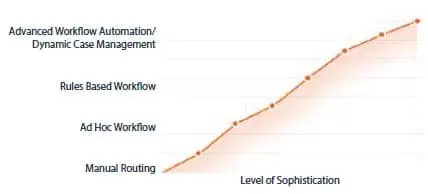Rules Based Workflow
Workflow automation is a big step up from an ad hoc workflow, it allows for pre-determined and standardised processes to be initiated and tasks to be routed without the need for user interaction.
It enables reactive routing that occurs automatically based on value authority, task completion, or specific events as defined by your specific business rules. Capture of a document or an event can automatically trigger a workflow of appropriate business processes involving both automatic and manual tasks.
Process Definitions provide structure and discipline with automated business rules, defined routing paths plus structured, automated and manual tasks which can have multiple steps. Processes are repeatable and standardised so they are consistently and automatically handled by the system.
Rules based workflows are also able to handle highly complex processes and the routing of multiple documents or a large volume of data.

Advanced Workflow Automation
Even within workflow automation, there are subtle differences that dramatically alter the performance of the technology.
Advanced Workflow Automation can be highly-structured, yet accommodate flexibility and knowledge-driven activities and tasks. Your software can then handle transitions between automation where applicable and ad hoc when necessary.
The ultimate goal is to streamline and automate as many tasks as possible, using people where they can be the most efficient and effective to perform tasks that cannot be effectively automated.
The primary variances within workflow automation software are fixed and dynamic queues, parallel process support and sophisticated case management capabilities, which will be explained in further detail below.
Now that the foundation of workflow automation has been set, let’s rewind and delve a bit deeper into each of the aforementioned variables. It was previously explained that ad hoc workflow is a more primitive form of workflow and does not handle automation.
Generally speaking, the inability to automate is major limitation for any organisation. Automation is ideal because it hardens and standardises common processes for consistency and scalability the enterprise. It also eliminates the need for manual and repetitive, allowing workers to focus on value added activities.
Yet there are situations where complete automation simply is not possible and user interaction is required in order to complete each unique process. This is often referred to as Dynamic Case Management.
This is where exceptions become necessary; unpredictable processes. These processes include knowledge workers that must take a proactive role in deciding the fate of each task.
Exceptions too often cripple an otherwise successful process. Sophisticated exception handling must be present and accounted for so that when unpredictable situations arise, the process doesn’t break down.

Workflow Automation
As previously mentioned, there are subtle differences in the technology behind the workflow automation software currently on the market.
A distinct power of having the most sophisticated workflow available is that while advanced capabilities are obtainable, the basic functions are still supported. This allows your business to have all the tools accessible to build a solution that truly fits your needs.
Ideally, your solution is all-encompassing. Thus, when your process requires ad hoc routing, it is available, but when dynamic queues and automation are essential for critical processes, your business will not be crippled by the limitations of your system.
Parallel Process Support
Parallel process support is vital to create a more effective workflow that is flexible and scalable to the growth and changes within a business. Traditional routing and ad hoc workflows are sequential; they follow a step by step order. Unable to support parallel processes, these workflow solutions cannot handle the more complex processes required to most effectively run a business.
More advanced workflow automation solutions al- low for tasks and projects to occur simultaneously. Multiple components of the same process can be completed in parallel; this eliminates unnecessary wait times; tasks are completed quicker and easier.